|
1979 - Tanks, plus... Tubular Bells!
By the 1970s turbo prop aircraft were becoming the obvious choice for business use. They could travel swiftly in western Europe, landing near where they were wanted rather than scheduled flights that could only use large airports. They needed Jet A1 fuel rather than the Avgas 100LL used by piston aircraft. A Beech King Air belonging to United Biscuits had been based at Denham for some years. The aerodrome’s tank was a modest sized bowser and deliveries were vulnerable to the good will of tanker drivers. So, the company decided that it needed to have a larger tank conveniently placed by the Blister hangar that it occupied.
The civil engineer who had first come to Denham to design and build the tarmac runway was asked to undertake this project. Donald Butler proceeded to plan the installation of a 12,000 gallon (54,480 litre) tank and appropriate pump. Planning permission was granted and work began on Tank 6 in November. The following pictures give some idea of what was involved.
|
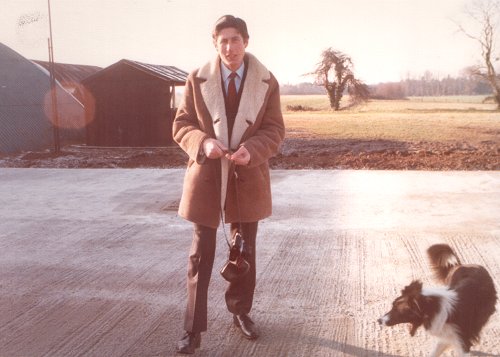
The civil engineer behind the runway and fuel tank installations at Denham was Donald Butler.
|
|

A 12,000 gallon underground tank required considerable excavation, the bottom of which was then lined with concrete.
|
|
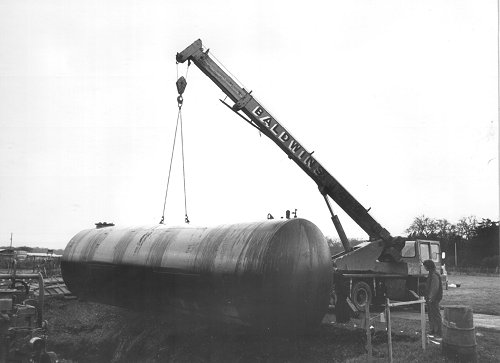
Lowering the tank into position required great care.
|
|
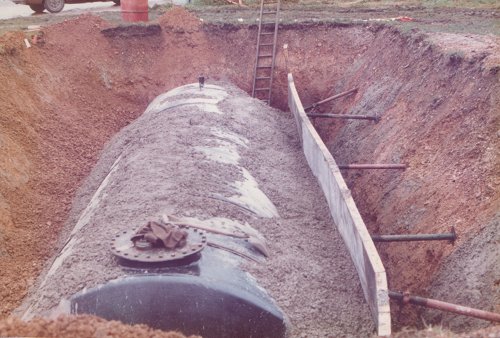
Once in position, the tank was filled with water to hold it down, and the task of encasing it in concrete and refilling the excavation could begin.
|
|
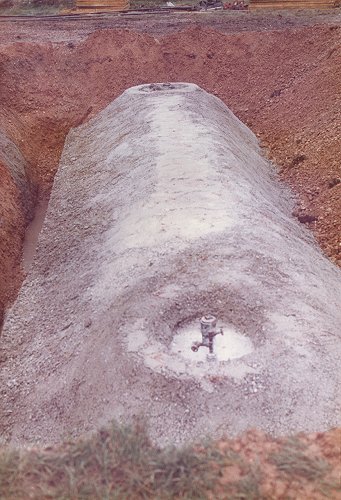
The fully enclosed tank, ready to be connected to the pump and filling systems. The concrete jacket served as protection for the tank.
|
|
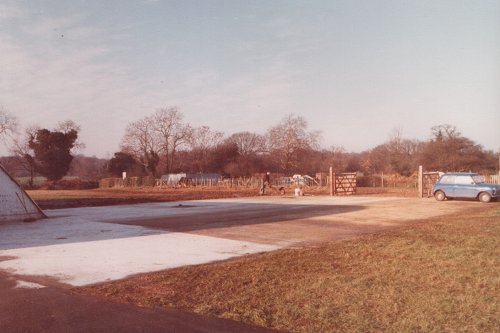
The site of the buried fuel tank, waiting for the pump to be added.
|
Since the aerodrome tanks for storing Avgas 100LL were also very modest it was decided that as the heavy equipment and expertise for installing Tank 6 was on site, it would be sensible to install a second Tank of 12,000 gallons (54,480) for this fuel. This was to be Tank 7, on the south side of the aerodrome near the flying school. It would eventually replace tank 1 of 1,000 gallons that had been built in the 1950s which was now no longer to be used, and tank 4 of 2,000 gallons built in the 1960s which continued to be used for a time for 80 octane Avgas or even Mogas. The old fire shed was removed and the whole site tidied. The new Tank 7 was attached to its own pump on the same hardstanding as the original pump to meet the needs of the aerodrome customers.
|
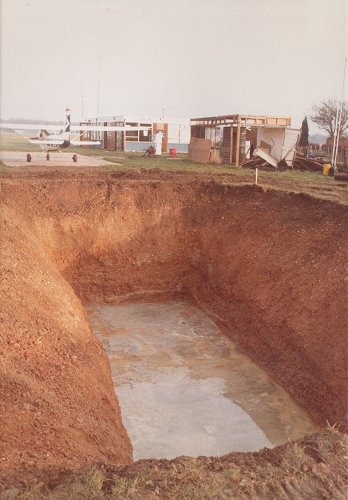
The excavation for Tank 7, is shown with its concrete base lining. The partially demolished fire station building can be seen on the right. Tank 1 and Tank 4 are underground near the pump.
|
|
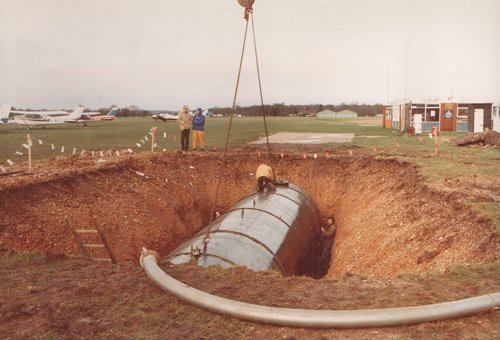
The scale of the tank is amply illustrated by the size of the people working on it. Ian Paul, himself a gas and oil pipeline engineer, can be seen on the left of the excavation.
|
|
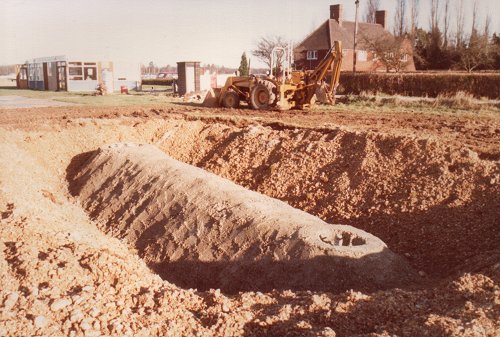
Tank 7 now encased in its concrete shell and ready to be covered. The aerodrome's own Massey Ferguson tractor, Nellie, was useful in recovering the site.
|
|
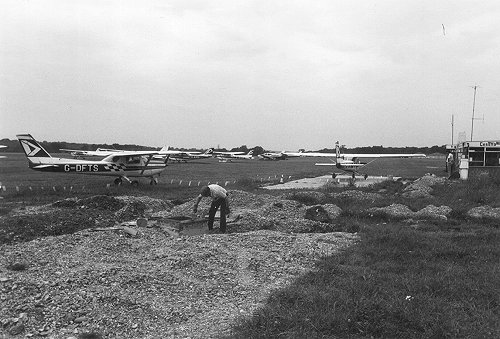
Groundsman Bill Hayden is here tidying up the site. He had come to the aerodrome in 1971, he and his wife lived in the bungalow in the north east corner.
|
One of the longest supporters of the aerodrome has been Owen Cubitt, who, while at the aerodrome, provided runway lighting and radio support. Owen was born in 1932 in Ealing, his father worked for the Admiralty Hydrographic Department throughout the Second World War preparing charts for the Royal Navy. Because of his work the family were posted to Exeter where Owen went to school. He then attended the Exeter Technical College gaining a City and Guilds in Electrical Engineering and Telecommunications. While studying, Owen had been working on aircraft magnetos at British Thompson Houston on day release from college. He was also a member of 1169 (Exeter) Squadron of the Air Training Corps, where he had gained his "B" licence flying gliders in 1947.
The family moved back to London that year, and in 1953, rather than the mandatory two years of National Service, Owen elected to join the Royal Air Force for three years, with an additional commitment to serve in the RAF Volunteer Reserve for five years after that. He was posted to RAF Benson as a cameraman and wireless operator with No. 82 Squadron, then equipped with Lancasters in the Photo Reconnaissance role. While with the Squadron, Owen gained his RAF pilot's licence on 6 October 1954, flying Tiger Moths in his spare time.
|
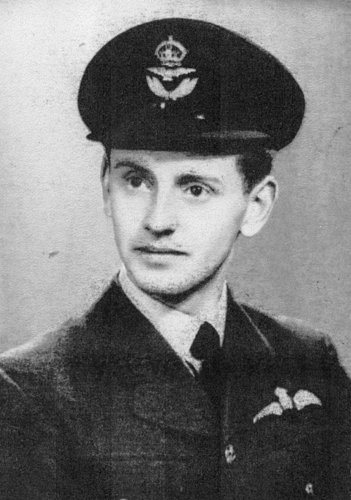
Owen Cubitt in RAFVR uniform as a Pilot Officer. He was radio engineer at Denham for many years.
|
With his full time service over, Owen was posted to Filton with the RAFVR, promoted from Sergeant to Pilot Officer and began flying the North American Harvard. Aside from the Harvard, Owen also flew the Airspeed Oxford to gain his twin rating, flying over 200 hours while a member of the RAFVR. At the same time, Owen had joined the Post Office as a communications engineer in his civilian life, and was to rise to become a projects manager with the Post Office Radio Branch and International Telecommunications Authority until his retirement in 1990.
|
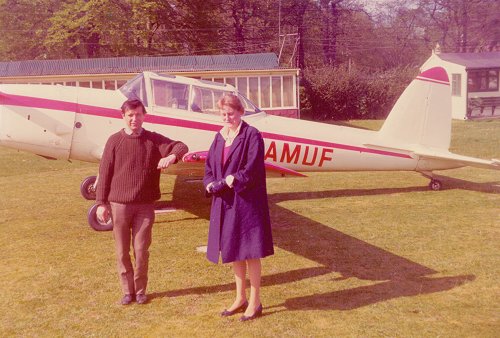
Owen Cubitt with aerodrome owner Beatrice Paul and Chipmunk G-AMUF, owned by Peter Bubiere and John Glanville seen in May 1975.
|
With the imminent closure of the RAFVR flying units in 1958, Owen and a group of friends got together and purchased an aircraft so they could continue flying privately. As already mentioned this was known as the Spartan Flying Group, flying the rare Spartan Arrow, G-ABWP, at Denham Aerodrome, which is where Owen's association with Denham began. Interestingly, the group continued flying without civil licences, using their RAF qualifications until the Air Ministry finally relented and issued Private Pilot's Licences to all RAF licence holders in 1961. The Spartan Group were to operate a number of different aircraft at Denham, their latest mount being de Havilland dHC-1 Chipmunk G-ATHD.
|

Owen Cubitt, a long time friend of Denham Aerodrome, seen in 1976 with Harry Elkin's Messerschmitt Me 208, an aircraft he helped to rebuild.
|
Another personality to be found on the aerodrome in 1979 was composer and musician Mike Oldfield, creator of such seminal albums as Hergest Ridge and Tubular Bells. He had learned to fly and moved into a farmhouse in Denham in order to be closer to the aerodrome. He was to own and operate several different types of aircraft from Denham, and went on to learn to fly helicopters as well as appearing in a BBC Blue Peter film about flying microlight aircraft.
|

Composer and musician Mike Oldfield owned this Beechcraft B24 Sierra 200 and flew it at Denham until he sold it in 1982.
|
The 1970s saw a gradual change in the facilities at the aerodrome. Change was to be a feature of the next decade as well, not just in the infrastructure, but in the companies and organisations using it. The helicopter operations of Air Gregory had steadily integrated with those of Point to Point Helicopters, the latter using the maintenance facilities of the former. Eventually, by 1979, Point to Point were to operate the helicopters while the last remaining part of Air Gregory was to maintain them. However, this situation was not to last long, as will be related in the next decade.
|
|

